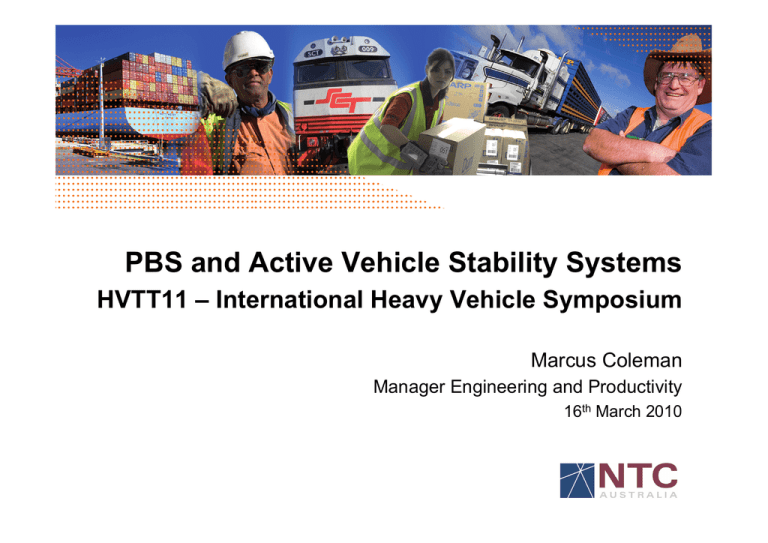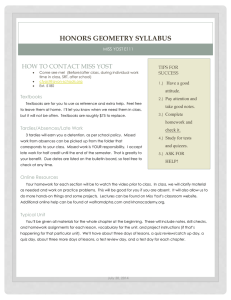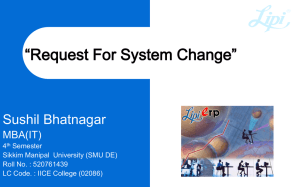PBS and Active Vehicle Stability Systems Marcus Coleman Manager Engineering and Productivity
advertisement

PBS and Active Vehicle Stability Systems HVTT11 – International Heavy Vehicle Symposium Marcus Coleman Manager Engineering and Productivity 16th March 2010 Performance Based Standards Productivity reform Voluntary Vehicles > 42.5 tonnes Safety + Infrastructure Protection Standards Performance Based Standards High-speed safety standards – Tracking Ability in a Straight Path (TASP) – Static Rollover Threshold (SRT) – Rearward Amplification (RA) – High-Speed Transient Offtracking (HSTO) – Yaw Damping Coefficient (YDC) – Handling Quality (HQ) – Directional Stability Under Braking (DSUB) Active Vehicle Stability Systems Electronic Control Systems that improve vehicle roll and/ or Roll Stability – Measure • Real time dynamic variables, e.g. wheel speeds, lateral acceleration, yaw rate, steer angle – Detecting Instability – Corrective Action • Selectively applying the brakes, controlling engine power or applying a steering input UNECE R13.11 "Vehicle Stability Function" means an electronic control function for a vehicle which improves the dynamic stability of the vehicle. A vehicle stability function includes one or both of the following: (a) directional control (b) roll-over control UNECE R13.11 "Directional control" means a function within a vehicle stability function that assists the driver, in the event of under steer and over steer conditions, within the physical limits of the vehicle in maintaining the direction intended by the driver in the case of a power-driven vehicle, and assists in maintaining the direction of the trailer with that of the towing vehicle in the case of a trailer. "Roll-over control" means a function within a vehicle stability function that reacts to an impending roll-over in order to stabilise the power-driven vehicle or towing vehicle and trailer combination or the trailer during dynamic manoeuvres within the physical limits of the vehicle." ECR R13.11 Annex 21 – Special requirements for vehicles equipped with a vehicle stability function – Prescribes technology requirements, e.g. must control left and right wheel speeds. No common test procedure Directional Control Roll-Over Control Reducing radius test Steady state circular test Step steer input test J-turn Sine with dwell J-turn µ-split single lane change Double lane change Reversed steering test or "fish hook" test Asymmetrical one period sine steer or pulse steer input test PBS vs ECE R13.11 stability requirements Roll stability Yaw stability ECE R13.11 • Power-driven vehicle roll-over control • Power-driven vehicle directional control (ESC) PBS • Static Rollover Threshold • Handling Quality ECE R13.11 • Trailer roll-over control (RSC) • Trailer directional control[1] • Static Rollover Threshold • Rearward Amplification • High-Speed Transient Offtracking • Yaw Damping Coefficient Truck Trailer PBS ECE R13 requires that power driven vehicles (categories M2, M3, N2 and N3) include directional control and roll-over control functionality whereas Trailers (categories O3, O4) need only include roll-over control function [1] Rollover PBS and ECE R13.11 rollover standards are most strongly aligned – Purpose (reduce the risk of rollover) – Applicability (Truck & Trailer) Some aspects of yaw stability control are aligned Static Rollover Threshold (SRT) Purpose: to limit the rollover tendency of a vehicle during steady turns Strong link to rollover crashes (US & NZ research) Essentially the same as ECE R111 – rollover stability of tank vehicles Static Rollover Threshold (SRT) PBS allows for SRT to be calculated using either of the following two test methods: – A constant radius quasi-steady turn – Tilt able – In accordance with recommended practice SAE J2180 Minimum tolerance level for lateral acceleration during a steady turn. – 0.40g for buses and dangerous goods vehicles – 0.35g for all other vehicles UNECE Rollover control function Roll Stability Control (RSC) A system that…reacts to an impending roll-over in order to stabilize the vehicle within the physical limits of the vehicle. Assume that the term ‘physical limits’ refers to the steady state rollover threshold (SRT) Mitigating Rollover Risk Two approaches: 1. Minimum physical tolerance to lateral acceleration (SRT) 2. Lateral Acceleration Management (RSC) SRT versus crash rate Vehicles with SRT below 0.35g more than 2 times more likely to be involved in a crash due to instability or rollover - Mueller, de Pont and Baas (1999) 15% of NZ HV Fleet but involved in 40% of the crashes Winkler et al (2000) have similar finding based on US 5axle semi-trailer Mueller, T.H., De Pont, J.J., Baas, P.H. (1999), Heavy Vehicle Stability Versus Crash Rates – Prepared by TERNZ for the Land Transport Safety Authority, New Zealand, July 9th 1999 RSC Effectiveness Woodrooffe et al (2009) – RSC would have been effective in preventing 3,282 (39.8%) of the 8,244 total annual rollover crashes (5-axle tractor semi-trailers) in the US. – In addition, they found that RSC was effective in preventing 207 (1.6%) of loss of control crashes. SRT versus RSC To compare effectiveness of two approaches use: relative crash rate = (1) From the Mueller, de Pont and Baas (1999) study: – vehicles with SRT ≤ 0.3 make up ≈ 2.5% of the fleet; – SRT between 0.3 and 0.35 make up ≈ 12.5% of the fleet. – Average relative crash rate of poor stability and marginal vehicles (SRT ≤ 0.35g) is estimated to be 3.92 SRT versus RSC Assume these vehicles are forced to have SRT of 0.35g – Relative crash rate drops from an average of 3.92 to 2.54 – Therefore 1.54 times less likely to be involved in a crash – Now 30% of vehicles in crashes (down from 40%) SRT: Overall crash reduction expected is about 14.1% RSC: 39.8% reduction in rollovers RSC Benefits Clear safety advantage, plus Productivity This data is from the study of the commissioned by the NRTC (Prem et al, 2002). Of the 139 vehicles types assessed 35 failed SRT, i.e. 7 (20%) were typically used to transport logs. Using RSC to gain productivity Question: Can RSC safely overcome these productivity limitations? Answer 1: Develop a performance test equivalent to the two already available for SRT, but: – Purpose of existing SRT tests is to measure the physical limits (SRT) of the vehicle, they do not represent real world driving scenarios – A vehicle with SRT < 0.35g will never pass the tilt test nor achieve the required speed to generate 0.35g on a quasisteady turn without rolling over. Using RSC to gain productivity Answer 2: Develop a performance test that determines whether or not RSC works effectively over a range of realistic operating scenarios. RSC performance test Woodruffe et al (2009) Developed manoeuvres based on road geometries found in the crash data • • • • Transient to constant curve (68m & 227m) Constant radius to diminishing curve Single lane change in curve Single lane change in straight (more severe than ISO lane change) • Turn at intersection Focus on curved roads: Of crashes benefiting from RSC – 82% curved dry roads – 12.4% straight dry roads – 5.6% curved wet roads RSC performance test Key factors – Repeatability – Comparability – Safety – Practicality – Cost – Robustness Australian factors – Overall length of combinations (up to 60m) – Availability of test facilities RSC performance test ECE R13.11 lists two alternative tests – Steady state circular test – J-turn No specifics about the test parameters, e.g. curve radius, entry speeds, etc. Woodrooffe et al (2009) developed three manoeuvres, including detailed test parameters, to investigate RSC efficacy on curves. RSC performance test Possible to construct a test that a vehicle with suitably high SRT would pass E.g. 68m transient to constant curve with typical entry speed of 55km/hr (Lateral acceleration = 0.35g) Transient to constant curve manoeuvre and results (Woodrooffe et al, 2009)[1] [1] The circles indicate that wheel lift-off occurred RSC performance test Provides direct comparison of the capability between a vehicle fitted with RSC and one that meets the 0.35g SRT standard Alternative: Constant radius to diminishing curve – Ensures that RSC works effectively when SRT is above 0.35g Principle of either approach is that the test demonstrates equal or better performance that a vehicle without RSC but with SRT > 0.35g RSC performance test Limits on curve radius – Should have lower limit to ensure the kinetic energy that braking system must overcome is realistic – Also, need to cater for long combination vehicles • But, Large radius are impractical – Need to determine smallest radii for robust test – Possibly develop minimum radius criteria based on overall length How low can SRT go? How low can SRT go? A model for combining the two methods of mitigating rollover risk. – The premise is that Equation (1) still holds relative crash rate = (1) – However, by fitting RSC you are proportionally less likely to have a crash. – The estimated 39.8% reduction in crashes resulting from RSC means that with RSC fitted a crash is 1.6 times less likely. – Dividing Equation (1) by 1.6 gives the following relative crash rate = (2) How low can SRT go? How low can SRT go? Suggests: – With RSC fitted vehicle with SRT of 0.28g (0.335g) is equivalent to one with 0.35g (0.4g) without SRT fitted – Despite being fitted with RSC there should be a lower limit for SRT – Limit will impact few designs - 96% of 139 Australian vehicles assessed have SRT below 0.35g (0.4g dangerous goods & buses) – Vehicles that fail are typically livestock and agriculture How low can SRT go? Suggests: – With RSC fitted vehicle with SRT of 0.28g (0.335g) is equivalent to one with 0.35g (0.4g) without SRT fitted – Despite being fitted with RSC there should be a lower limit for SRT – Limit will impact few designs - 96% of 139 Australian vehicles assessed have SRT below 0.35g (0.4g dangerous goods & buses) – Vehicles that fail are typically livestock and agriculture Rollover Summary Electronic roll stability systems are effective in reducing road trauma RSC is more effective at reducing rollover than setting a minimum SRT limit There is a good case for allowing ECE R13.11 certified roll stability control in lieu of meeting the PBS SRT requirements The existing SRT test is insufficient for demonstrating the effectiveness of RSC; any alternative standard should demonstrate that the vehicle is as stable as a vehicle with SRT of 0.35g through realistic curved road geometry Directional and yaw stability standards Handling Quality (HQ) – Power-driven vehicle directional control – PBS Handling Quality and UNECE Power-driven vehicle directional control appears to align well – However, currently PBS has not defined the handling quality measure as it is too hard to find measure – ESC may be a way forward – FORS study recommended that regulatory controls be put in place to control certain characteristics of suspensions and steering systems fitted to prime movers – ESC is effective in reducing road trauma but will not directly address the issues/recommendations of FORS study Directional and yaw stability standards Handling Quality (HQ) – Power-driven vehicle directional control – ESC offers hope for robust handling quality standard – ESC test would effectively mandate the technology – ESC must be tested on low friction surface, e.g. ice – Test facilities not available in Australia – ADR’s appropriate regulatory mechanism to mandate new technologies – Australia sources equipment from USA, EU and Japan so must wait until source countries have capability Directional and yaw stability standards Trailer yaw stability – PBS has very specific trailer yaw stability requirements – ECE R13.11 doesn’t mandate trailer directional control – Potential for marginal vehicles to meet standard with technologies – Australian developed technologies have been designed for this purpose Tracking Ability in a Straight Path (TASP) – Does not relate directly to ECR EVCS requirements – Potential for TASP to be improved with EVCS – Many PBS vehicles are on the limit Directional and yaw stability standards Directional Stability Under Braking (DSUB) – Aligns with traditional ECE R13 requirements – Requires certain deceleration levels and no ‘gross wheel lockup’ when decelerating from 60km/hr – Essentially mandates load-proportioning or ABS brakes Conclusions & Recommendations Electronic roll stability systems are effective in reducing rollover and road trauma; moreover, RSC is more effective at reducing rollover than setting a minimum SRT limit of 0.35g. There are potential productivity benefits from adopting RSC technologies on vehicles with marginal SRT performance. Fitment of a rollover control system that complies with ECE R13.11 should be adopted as an alternative (Deemed to Comply provision) to the PBS Static Rollover Standard. Despite the fitment of RSC technologies there should be a minimum level of SRT specified – 0.335g for tankers and buses and 0.28g for all other vehicles fitted with a compliant RSC system. ADRs are the best regulatory mechanism for phasing in this fleetwide take up of new RSC and ESC technology.





